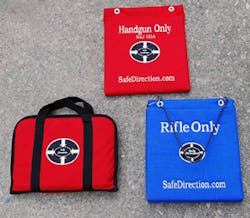Let's Stop Shooting Each Other
We're shooting each other. Just this week on Officer.com police related headlines from across the country have reported that officers have: shot themselves, shot other officers and allowed a three year old son access to a live firearm which resulted in the boy shooting himself. Tragedy, stupidity and complacency are to blame. This must stop and here's how we’ll fix it.
Four Firearms Safety Rules
The universal four basic firearm safety rules have stood the test of time and bare repeating. They are:
- Treat every firearm as if it were loaded.
- Don't point the muzzle at anything you don't wish to shoot, kill or destroy.
- Keep your finger off the trigger until you've made the conscious decision to shoot.
- Be sure of your target and what's behind it.
Familiarity Breeds Contempt
A fellow firearms instructor tells students, "I'm good with a gun. Matter-of-fact I'm so good I'm probably on the verge of having an accidental discharge." His point is that some of us deal with firearms on such a regular basis that when a gun (pistol, subgun, shotgun or carbine) is in our hands it is as if magic happens. So practiced are we that we are beginning to act without conscious thought in terms of safety and this is extremely bad.
To counter-act the possibility of experiencing an accidental discharge we should do things methodically. We should have a methodical system to both:
- load from the holster and make ready, and
- unload, clear and re-holster.
- Draw to full presentation;
- Bring the Weapon back into your "workspace";
- Remove the source of ammunition (magazine) and place it in your pocket;
- Lock the slide to the rear;
- Visually and manually check to make sure that the chamber and magazine well are empty;
- Look away and then visually/manually check the pistol again (ever look at your watch only not see what time it was only to have to repeat it? Same concept...).
To load, once again on the line or while pointed at a charging barrel, safe backstop or Safe Direction pad, you:
- Draw to full presentation;
- Bring the pistol back into the workspace;
- Lock the slide to the rear;
- Load a magazine from a magazine carrier;
- Manually operate the slide or use the slide stop to chamber a round while coming back on target with a good sight picture;
- Start breathing and expanding you vision;
- Return to high-ready and perform a press check;
- Return to the holster.
Training Tools and Devices
Sadly even firearms instructors have fallen victim to the "familiarity breeds contempt" rule which has resulted in instructors wounding and killing students as well as themselves. Sound training devices exist which can reduce the need to demonstrate with live firearms. Rings® Blueguns are available in all makes and models and are closely molded so that they can be holstered (an issue with today's injection molded holsters). Unless the situation calls for airsoft, Simunitions® FX cartridge training or dry fire using real firearms, use Blueguns - they are much safer. Glock, as an example, has the non-functional red framed Training Pistol. This solid barrel training devices can seat a magazine, chamber a training round and has the same trigger press as a standard Glock but can be safely used in the classroom.
Although barrel blocks can be made from electrical zip ties or colored paracord, commercial versions are available. Bladetech® has recently developed a Training Barrel made of polymer that replaces the barrel on many pistols. This yellow solid plastic barrel allows safer dry fire practice in basic firearms programs.
Inert training rounds are a must and I prefer those from Law Enforcement Targets. These metal case training rounds feature orange plastic "bullets" and because of the brass cases can be cycled hundreds of times without damage.
I've already mentioned Safe Direction but I would like to talk about some of their innovative products. With products such as: The Academy Pad (which can fit in a three ring binder); Pro Shooting Bag; Armorer's Transport Cases; and Wall Board for both Pistol and Rifle, Safe Direction offers much to provide easily portable ballistic containment. Safe Direction products are sound, inexpensive and a worthwhile investment for every agency.
Accidental, Unintentional or Negligent Discharge
Let's not get hung up on what we call the incident as it serves no purpose, let's focus on prevention. Let's conduct firearms training and unloading, clearing and cleaning as well as the subsequent loading process methodically and as safely as possible. Let's be victors from our training experience not victims to it. Remember the four firearms safety rules and always handle firearms with conscious thought and with safety in mind at all times.
